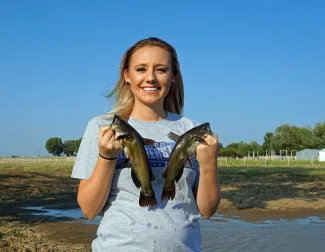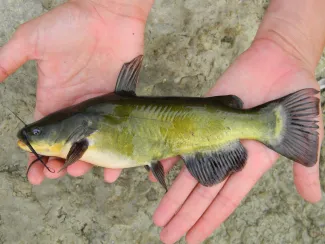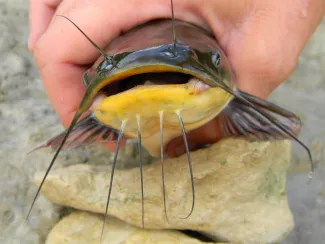When you think of farm pond management and what kind of fish to put in your pond, bullheads might not be the first thing that comes to mind. In fact, some of the things you read about pond management will tell you these catfish are a bad idea. But are they really?
When I was a kid, bullheads (also known as mudcats) were one of our favorite things to fish for and we’d walk almost any distance to catch one. We had no idea they were an undesirable “nuisance species” until we were nearly grown and read it in a magazine. Personally though, I’ve never really bought into it and even now am known to drive an hour and half to fish a “top-secret” mudcat pond in a Tulsa apartment complex.

So what are the arguments against bullheads in farm ponds? The biggest is that bullheads can overpopulate and stunt in ponds, and this is absolutely true. But so can (and do) largemouth bass, channel catfish and bluegill, which are the same species all the pond management books recommend stocking. In fact, any species that can reproduce in ponds is capable of stunting and overpopulating.
The next argument is usually that bullheads don’t really get big enough to be of much use. I disagree completely. Half-pound to 1 ½-pound farm pond mudcats are pretty common and fish over 2 pounds are just starting to get into trophy range. It’s true they’ll never reach 10 pounds in a pond (though the Oklahoma state record is nearly 7 pounds and from a pond), but realistically not many channel catfish do either and a ½-pound bullhead is more than big enough to put a smile on the face of anyone holding a fishing pole.

Another common argument is that mudcat aren’t good to eat. This is sometimes true - they can be very good to eat or not good at all. Just like channel catfish, in some ponds and at certain times of the year, they can definitely have a muddy off-flavor. Otherwise, they’re great eating. As a general rule, if the fish has dark yellow or red streaks, those should be cut out of the meat. Off-flavor seems to be most common in both channel catfish and bullheads in late summer when water quality is often the worst.
Another argument you sometimes hear is that bullheads can make your pond muddy. Maybe … but if your pond is in Oklahoma, there’s a pretty good chance its already doing a great job at being muddy all on its own (and bullheads most likely won’t make it any more muddy). Plus, if you’re like most pond owners your ponds primary purpose is watering livestock, which love to wade in the shallow water while stirring up sediment in the summer.
So what are the advantages to bullheads in a pond? Far and away the biggest advantage of bullheads is their catchability. Mudcats aren’t peckers, nibblers or bait stealers- they’re gobblers and they do it with gusto. They love to eat and day or night, rain or shine, you can pretty much always catch a mudcat. Another great thing about them is you don’t need any fancy gear or bait to do it. A Zebco 33 and a worm, grasshopper or chunk of hotdog will catch any bullhead out there. The great naturalist and philosopher Henry David Thoreau probably summed up the bullheads feeding habits best when he said “they will take any kind of bait from angleworms to a piece of tomato can.”
An interesting fact about bullheads is that they have “taste buds” on the outside of their skin, meaning their whole body basically functions as a food seeking antenna. I once watched a bullhead in clear water dart like a missile from under a rock, to eat a piece of worm 20 feet away that had been lying on bottom less than three seconds. They are very good at finding food.

Another advantage of bullheads is that you don’t have to wonder if they’ll do well in your pond. They will. Some ponds simply don’t make good bass ponds or even channel catfish ponds, but they can still make great bullhead ponds. Bullheads have some of the lowest habitat and water quality requirements of any Oklahoma fish, and as long as your pond has water in it (and sometimes even if it doesn’t for short periods) bullheads will almost certainly grow and reproduce in it.
So, should you put bullheads in your pond? That really depends on what you have to work with and what you want. If you have a beautiful, clear, five-acre pond with standing timber and you want to catch largemouth bass on top-waters while watching the sun set, bullheads probably aren’t what you’re looking for. Although bullheads do make excellent forage for bass, so much so that they have a hard time persisting in ponds with even modest bass densities.
If you have a couple acre pond and you’re planning to fence off livestock, install channel catfish feeders, periodically evaluate and stock forage, and actively manage the harvest of bass and channel cat, then bullheads again probably don’t have a place in your pond. But if you have a ¼- to 1 ½-acre bowl-shaped, muddy pond and you just want a place to take your kids or grandkids fishing, then mudcats might be exactly what you’re looking for. There’s no better fish to introduce kids to fishing and even serious fishermen might find themselves skipping the top-waters and reaching for a chunk of hotdog to toss out on the bottom.